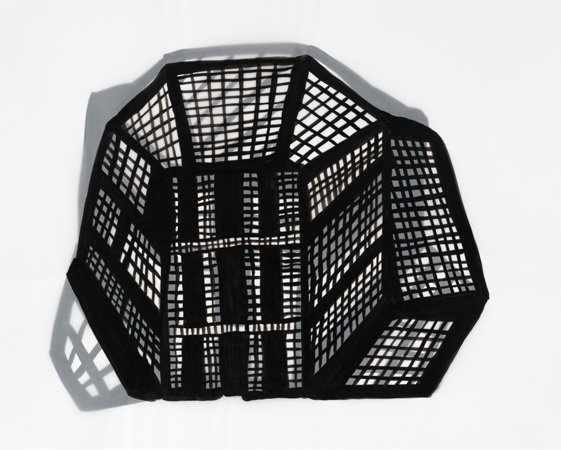Susan Hefuna
Cairotraces
14 October–22 November 2014
Private view: 13 October, 17:30–21h
Pi Artworks London
55 Eastcastle Street
London W1W 8EG
Hours: Monday–Friday 10am–6pm,
Saturday 11am–6pm
Pi Artworks London is pleased to announce Susan Hefuna’s third solo exhibition with the gallery and her first at our London venue. Cairotraces features a new series of her highly regarded works on paper as well as a newly commissioned palm wood installation that are influenced by the streets of a city that has been a reoccurring influence in her work.
At the core of Hefuna’s practice is her fascination with the networks and structures of connection that inhabit public spaces and become the framework for peoples’ interactions with each other. She is particularly interested in how these networks become visible through and influenced by architectural models and city planning. For Hefuna, these public spaces, particularly urban centres, are the intersection of politics, architecture, and history and they shape the formation of different social identities. This interest stems from the artists’ dual German-Egyptian heritage, which has allowed her to observe the towns and cities of two cultures that are simultaneously foreign and familiar to her as well as her nomadic existence as an artist who immerses herself in the life of the various countries she works and exhibits in.
Since the late ’90s, Hefuna has used the structural forms of the mashrabiya screens she originally observed in Cairo to visualise her anthropological inquiry into public spaces. Mashrabiyas are traditional latticework screens built out of interconnected knobs and rods that form unbroken, crosshatch patterns; they beautify buildings while protecting the inhabitants from harsh sunlight. For the artist, these screens reflect many of the key issues that affect the interactions she observes on a day-to-day basis: the delineation between private and public space, veiling, and voyeurism. Hefuna’s mashrabiyas’ interconnected dot-and-line motifs, often interwoven with words or phrases, are a template with which she can reify the intangible networks and structures of connection that inhabit public spaces and become the framework for people’s interactions.
Hefuna’s current work also suggests other interlocking structures, such as DNA, embroidery, tapestry, molecular structures and, most significantly, buildings and maps. The viewer is not innocent and reads the work differently depending on their cultural or social background.
Upon arriving at a new location, Hefuna spends a few days traversing its streets and squares until this calmative process lulls her into a state in which she feels ready to compose work that will captures the atmosphere of the location. Her initial artistic response is usually a series of delicately composed ink and pencil drawings. These start with a single dot and line that is unfolded in a single session without the nib ever leaving the paper. In their humble and austere nature, these structures recall the drawing experiments of the American Minimalists. However, they do not conform to a strict pre-determined system but instead are intuitively composed and open to changes and subversions that are influenced by her location. Each finished piece relates to a place, a city, a body, a history, memory, that combines the experiential with the abstract, without ever subjugating one to the other.
Accompanying these drawings will be a series of cubic, palm wood structures similarly conceived and constructed in the Egyptian capital. These act as three-dimensional renderings of the exhibited drawings. Both the two-dimensional and three-dimensional work share similar fragile and porous crosshatch layers, yet the latter can be viewed from several perspectives. This allows the viewer to experience the interplay of light and shadow that changes through the day, therefore more literally reflecting the architectural resonances within Hefuna’s practice.
Hefuna has had solo exhibitions in 2014 at The Sharjah Art Foundation, Sharjah, UAE ; the Osthaus Museum, Hagen, Germany; both branches of Pi Artworks; and Rhona Hoffman Gallery, Chicago. Other recent solo exhibitions include Notationsnotation at the Drawing Center in New York City (2013); Susan Hefuna at Rossa Issa projects, London, 2013; Vantages at the MAD Museum in New York City (2012–13); Susan Hefuna at Rhona Hoffman Gallery in Chicago (2012); and I Love Egypt – A Temporary Learning Camp, a collaborative commission by The Serpentine Gallery, London and Townhouse, Cairo, which took place at London’s Speaker’s Corner in 2011. Hefuna was the recipient of the 2013 Contemporary Drawing Prize of the Daniel & Florence Guerlain Art Foundation in Paris. She has also had her work exhibited at Fare Mondi as part of the 53rd Venice Biennale in 2009. Public collections include the Centre Pompidou, Paris; LACMA, Los Angeles; British Museum, London; MoMA, New York; Farjam Collection, Dubai, UA; Institut du Monde Arabe, Paris; Victoria and Albert Museum; London; Staatsgalerie, Stuttgart, Germany; Collection HH Sheika Salama, Abu Dhabi; Sharjah Art Foundation, Sharjah and Foundation Louis Vuitton, Paris. Hefuna has collaborated on numerous publications including the three volume Pars Pro Toto series with Hans Ulrich Obrist, with the third volume launched at Art Dubai, UAE in early 2014. In late 2014 Kehrer Heidelberg Berlin released a book dedicated to her recent “Buildings” series to accompany her solo exhibition at Osthaus Museum, Hagen, Germany.
For press information and images, please contact Neil Jefferies: nj@piartworks.com or call +44 207 637 8403.
